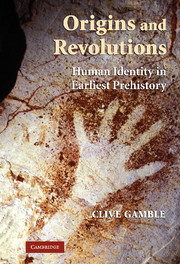Crossref Citations
This Book has been
cited by the following publications. This list is generated based on data provided by Crossref.
James, Wendy
2007.
Choreography and Ceremony: The Artful Side of Action.
Human Affairs,
Vol. 17,
Issue. 2,
p.
129.
Roskams, Steve
and
Whyman, Mark
2007.
Categorising the past: lessons from the archaeological resource assessment for Yorkshire.
Internet Archaeology,
Renfrew, Colin
Frith, Chris
Malafouris, Lambros
Coward, Fiona
and
Gamble, Clive
2008.
Big brains, small worlds: material culture and the evolution of the mind.
Philosophical Transactions of the Royal Society B: Biological Sciences,
Vol. 363,
Issue. 1499,
p.
1969.
Renfrew, Colin
Frith, Chris
Malafouris, Lambros
and
Malafouris, Lambros
2008.
Between brains, bodies and things:tectonoeticawareness and the extended self.
Philosophical Transactions of the Royal Society B: Biological Sciences,
Vol. 363,
Issue. 1499,
p.
1993.
Renfrew, Colin
Frith, Chris
Malafouris, Lambros
and
Renfrew, Colin
2008.
Neuroscience, evolution and the sapient paradox: the factuality of value and of the sacred.
Philosophical Transactions of the Royal Society B: Biological Sciences,
Vol. 363,
Issue. 1499,
p.
2041.
Kristiansen, Kristian
2008.
The dialectic between global and local perspectives in archaeological theory, heritage and publications.
Archaeological Dialogues,
Vol. 15,
Issue. 1,
p.
56.
Braun, David R.
and
Hovers, Erella
2009.
Interdisciplinary Approaches to the Oldowan.
p.
1.
Soffer, Olga
2009.
Sourcebook of Paleolithic Transitions.
p.
43.
TOMKINS, PETER
2009.
DOMESTICITY BY DEFAULT. RITUAL, RITUALIZATION AND CAVE-USE IN THE NEOLITHIC AEGEAN.
Oxford Journal of Archaeology,
Vol. 28,
Issue. 2,
p.
125.
Barrett, John C.
and
Ko, Ilhong
2009.
A phenomenology of landscape.
Journal of Social Archaeology,
Vol. 9,
Issue. 3,
p.
275.
Gowlett, John A. J.
2009.
Sourcebook of Paleolithic Transitions.
p.
65.
Bailey, Geoff
and
Galanidou, Nena
2009.
Caves, palimpsests and dwelling spaces: examples from the Upper Palaeolithic of south-east Europe.
World Archaeology,
Vol. 41,
Issue. 2,
p.
215.
Gamble, Clive
2009.
Human display and dispersal: A case study from biotidal Britain in the Middle and Upper Pleistocene.
Evolutionary Anthropology: Issues, News, and Reviews,
Vol. 18,
Issue. 4,
p.
144.
Gowlett, John A. J.
2010.
New Perspectives on Old Stones.
p.
295.
Jusseret, Simon
2010.
Socializing geoarchaeology: Insights from Bourdieu's theory of practice applied to Neolithic and Bronze Age Crete.
Geoarchaeology,
Vol. 25,
Issue. 6,
p.
675.
Gamble, Clive
2010.
Book review: Livingstone, D.N. 2008: Adam’s ancestors: race, religion and the politics of human origins. Baltimore, MD: The Johns Hopkins University Press. 320 pp. US$35 cloth. ISBN: 978 0 8018 8813 7.
Progress in Human Geography,
Vol. 34,
Issue. 2,
p.
277.
Malafouris, Lambros
2010.
The brain–artefact interface (BAI): a challenge for archaeology and cultural neuroscience.
Social Cognitive and Affective Neuroscience,
Vol. 5,
Issue. 2-3,
p.
264.
Brittain, Marcus
and
Harris, Oliver
2010.
Enchaining arguments and fragmenting assumptions: reconsidering the fragmentation debate in archaeology.
World Archaeology,
Vol. 42,
Issue. 4,
p.
581.
Davidson, Iain
2010.
The archeology of cognitive evolution.
WIREs Cognitive Science,
Vol. 1,
Issue. 2,
p.
214.
Conkey, Margaret W.
2010.
Images without Words: The Construction of Prehistoric Imaginaries for Definitions of ‘Us’.
Journal of Visual Culture,
Vol. 9,
Issue. 3,
p.
272.



